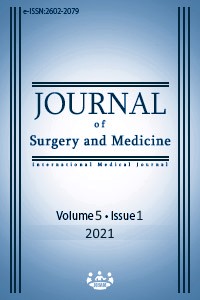The effect of change in educational model on surgical antimicrobial prophylaxis
Keywords:
Antibiotics, surgical site infection, Prophylaxis, Education, InterventionAbstract
Background/Aim: Surgical antibiotic prophylaxis is one of the important steps in preventing surgical site infections. Compliance with the guidelines is particularly important and there are problems in this regard. Innovative approaches are needed in education. In our study, the effects of the novel face-to-face training and feedback model, with which we obtained positive results, were shown. Methods: In this retrospective cross-sectional study, surgical site infections and the use of antibiotics in surgical prophylaxis in all patients undergoing certain operations were examined in pre-determined departments. The quarterly or annual changes in compliance rates were compared with the new education model. Results: A total of 3697 clean surgeries were assessed in three departments. The cardiovascular surgery department had annual compliance rates of 2.5% and 8.6% in 2010 and 2011, respectively, which increased between 2012-2017 from 64.5%, 90.7%, 85.4%, 98.8%, 90.6% to 97.4%, respectively (P<0.001), with the new training model. In the Orthopedics and Traumatology department, within eight 3-month periods between 2014 and 2016, compliance rates increased from zero to 92.4% (P<0.001). The general surgery department had a 3.3% compliance rate at the beginning of 2015, which increased up to 98.3%, 95.3%, 96.8% and 93.5% in three-month intervals in 2017 (P<0.001). No significant changes were identified in surgical site infection rates. Conclusion: Continuous training, monitoring and feedback is required for guideline compliance in surgical antibiotic prophylaxis. We think narrow-scoped and target-oriented face-to-face training is effective and applicable.
Downloads
References
Burke JP. Infection control - a problem for patient safety. N Engl J Med. 2003;348(7):651-6.
Kirkland KB, Briggs JP, Trivette SL, Wilkinson WE, Sexton DJ. The impact of surgical-site infections in the 1990s: attributable mortality, excess length of hospitalization, and extra costs. Infect Control Hosp Epidemiol. 1999;20(11):725-30.
Berrios-Torres SI, Umscheid CA, Bratzler DW, Leas B, Stone EC, Kelz RR, et al. Centers for Disease Control and Prevention Guideline for the Prevention of Surgical Site Infection, 2017. JAMA Surg. 2017;152(8):784-91.
Bratzler DW, Dellinger EP, Olsen KM, Perl TM, Auwaerter PG, Bolon MK, et al. Clinical practice guidelines for antimicrobial prophylaxis in surgery. Am J Health Syst Pharm. 2013;70(3):195-283.
Kaya S, Aktas S, Senbayrak S, Tekin R, Oztoprak N, Aksoy F, et al. An Evaluation of Surgical Prophylaxis Procedures in Turkey: A Multi-Center Point Prevalence Study. Eurasian J Med. 2016;48(1):24-8.
Bozkurt F, Kaya S, Gulsun S, Tekin R, Deveci O, Dayan S, et al. Assessment of perioperative antimicrobial prophylaxis using ATC/DDD methodology. Int J Infect Dis. 2013;17(12):e1212-7.
Prado MA, Lima MP, Gomes Ida R, Bergsten-Mendes G. The implementation of a surgical antibiotic prophylaxis program: the pivotal contribution of the hospital pharmacy. Am J Infect Control. 2002;30(1):49-56.
Knox MC, Edye M. Educational Antimicrobial Stewardship Intervention Ineffective in Changing Surgical Prophylactic Antibiotic Prescribing. Surg Infect (Larchmt). 2016;17(2):224-8.
Ozgun H, Ertugrul BM, Soyder A, Ozturk B, Aydemir M. Peri-operative antibiotic prophylaxis: adherence to guidelines and effects of educational intervention. Int J Surg. 2010;8(2):159-63.
Saied T, Hafez SF, Kandeel A, El-kholy A, Ismail G, Aboushady M, et al. Antimicrobial stewardship to optimize the use of antimicrobials for surgical prophylaxis in Egypt: A multicenter pilot intervention study. Am J Infect Control. 2015;43(11):e67-71.
Putnam LR, Chang CM, Rogers NB, Podolnick JM, Sakhuja S, Matusczcak M, et al. Adherence to surgical antibiotic prophylaxis remains a challenge despite multifaceted interventions. Surgery. 2015;158(2):413-9.
Li X, Chen H, Zhu S, Liu Y, Yang J, Yuan Z, et al. Efficacy and feasibility of a collaborative multidisciplinary program for antibiotic prophylaxis in clean wound surgery. Int J Clin Pharm. 2018;40(1):150-9.
So JP, Aleem IS, Tsang DS, Matlow AG, Wright JG, SickKids Surgical Site Infection Task F. Increasing Compliance With an Antibiotic Prophylaxis Guideline to Prevent Pediatric Surgical Site Infection: Before and After Study. Ann Surg. 2015;262(2):403-8.
Tunger O, Karakaya Y, Cetin CB, Dinc G, Borand H. Rational antibiotic use. J Infect Dev Ctries. 2009;3(2):88-93.
Altunsoy A, Aypak C, Azap A, Ergonul O, Balik I. The impact of a nationwide antibiotic restriction program on antibiotic usage and resistance against nosocomial pathogens in Turkey. Int J Med Sci. 2011;8(4):339-44.
Downloads
- 476 589
Published
Issue
Section
How to Cite
License
Copyright (c) 2021 Celali Kurt
This work is licensed under a Creative Commons Attribution-NonCommercial-NoDerivatives 4.0 International License.
















